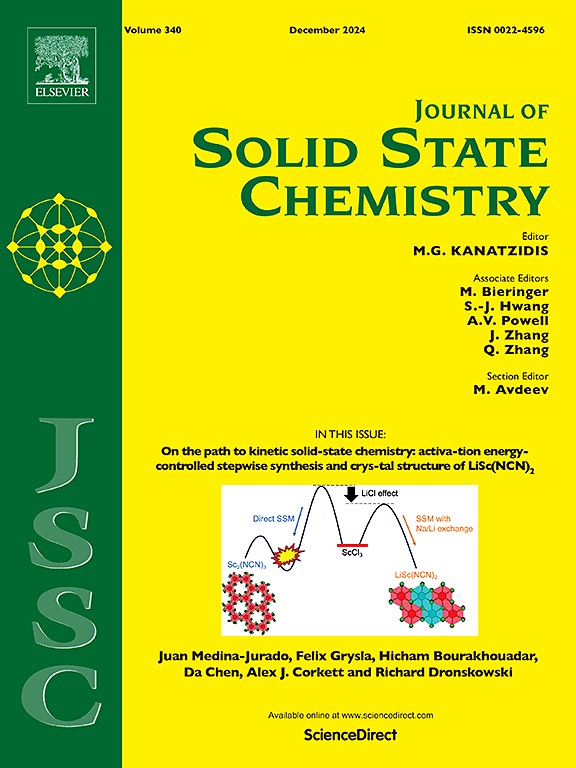Magnetic properties of new binary compounds lead-free ferroelectric (1-x)Ba(Zr0·2Ti0.8)O3+xFeTiO3 as solid solution
IF 3.2
3区 化学
Q2 CHEMISTRY, INORGANIC & NUCLEAR
引用次数: 0
Abstract
In this work, the complex properties of new binary lead-free ferroelectric Ba(Zr0·2Ti0.8)O3 modified with ilmenite-type FeTiO3 materials were reported. Crystal structure analysis using X-ray diffraction and phonon vibration modes studied through Raman scattering indicate that Ba(Zr0·2Ti0.8)O3 well-formed solid solutions with FeTiO3. The random distribution of Fe cations at both the A- and B-sites in the perovskite structure of Ba(Zr0·2Ti0.8)O3 results in lattice parameter distortion and a reduction in the optical band gap energy from 3.17 eV in pure Ba(Zr0·2Ti0.8)O3 to 2.82 eV at 7 mol.% FeTiO3. Furthermore, the introduction of FeTiO3 significantly enhances the weak ferromagnetism naturally present in pure Ba(Zr0·2Ti0.8)O3, while maintaining the ferroelectric properties across all compositions. Observing this biferroic behavior at room temperature in the FeTiO3-modified Ba(Zr0·2Ti0.8)O3 system suggests promising applications for lead-free ferroelectric materials in next-generation electronic devices. We expect that this work will further open new directions in tailoring ferromagnetic properties in environmentally friendly ferroelectric materials for advanced electronic applications.

新型无铅铁电化合物(1-x)Ba(Zr0·2Ti0.8)O3+xFeTiO3固溶体的磁性能
本文报道了钛铁矿型FeTiO3改性的新型二元无铅铁电材料Ba(Zr0·2Ti0.8)O3的复合性能。利用x射线衍射和拉曼散射对Ba(Zr0·2Ti0.8)O3晶体结构进行了分析,表明Ba(Zr0·2Ti0.8)O3与FeTiO3形成良好的固溶体。Ba(Zr0·2Ti0.8)O3钙钛矿结构中A位和b位上Fe阳离子的随机分布导致晶格参数畸变,光学带隙能量从纯Ba(Zr0·2Ti0.8)O3时的3.17 eV降低到7mol .% FeTiO3时的2.82 eV。此外,FeTiO3的引入显著增强了纯Ba(Zr0·2Ti0.8)O3中天然存在的弱铁磁性,同时保持了所有成分的铁电性。在室温下观察fetio3修饰的Ba(Zr0·2Ti0.8)O3体系的这种双稳态行为,表明在下一代电子器件中无铅铁电材料的应用前景广阔。我们期望这项工作将进一步开辟新的方向,为先进电子应用量身定制环保铁电材料的铁磁性。
本文章由计算机程序翻译,如有差异,请以英文原文为准。
求助全文
约1分钟内获得全文
求助全文
来源期刊

Journal of Solid State Chemistry
化学-无机化学与核化学
CiteScore
6.00
自引率
9.10%
发文量
848
审稿时长
25 days
期刊介绍:
Covering major developments in the field of solid state chemistry and related areas such as ceramics and amorphous materials, the Journal of Solid State Chemistry features studies of chemical, structural, thermodynamic, electronic, magnetic, and optical properties and processes in solids.
 求助内容:
求助内容: 应助结果提醒方式:
应助结果提醒方式:


